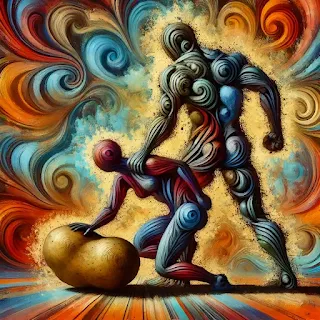Strategic listening is the phenomenon where people “listen” without any real intention of understanding, aiming instead to maintain a superficial interaction that serves their own purposes. In contemporary societies, the pressure to show immediacy and “knowledge” often leads to rushed, pre-packaged responses. However, this superficial communication alienates people and results in an empty exchange of ideas, where genuine understanding is rarely achieved. As Goffman (1959) observes, this need for “projection” and self-affirmation functions as a social “performance” that ultimately reinforces social distance instead of fostering mutual understanding.
Nichols (2009) argues that genuine listening is a fundamental practice for healthy relationships, as it allows us to overcome the obstacles of self-centered perception and truly connect with others. In contrast, those who engage in strategic listening ignore this benefit and are caught in interactions that resemble more of a pretence of dialogue rather than authentic communication.Many choose to listen strategically, maintaining a distance to avoid commitment or exposure to new ideas. This approach does not go unnoticed: those who practice it often reveal themselves through their mechanical responses and indifference toward the other person. As Hochschild (1983) notes, strategic listening is a form of “emotional labour” that ends up functioning more as manipulation than as a genuine approach, creating relationships that are superficial rather than meaningful.
The phenomenon of strategic listening is rooted in social and psychological pressures. We live in a world where speed and the projection of knowledge have become ultimate values. People feel pressured to respond immediately and without hesitation, fearing they may appear “uninformed” or “slow.” This pressure leads to a superficial approach to listening, where the response is not a product of understanding but a standardized reaction based on preconceived notions and stereotypes. Argyris (1990) observes that this practice actually undermines organizational learning and growth, as it excludes the genuine engagement and critical thinking necessary for progress.
The workplace is one environment where strategic listening has become entrenched, especially in roles such as those of managers. For obvious reasons, managers often need to appear as if they are listening to their employees without necessarily giving full attention or committing to every suggestion. This practice is particularly evident in cases where balance must be maintained and authority or established plans should not be questioned. Hypocritical listening thus becomes a management tool that allows managers to show they take others' opinions into account without threatening decisions or strategic direction. This is a form of control over information and expectations, often serving organizational goals but frequently damaging employee trust. Employees, aware of this practice, end up feeling distanced or losing interest, creating a cycle of lack of genuine communication and mutual understanding.
In contrast to strategic listening, the spiritual dimension of communication can serve as an antidote and a response to this superficial behaviour. Genuine listening is not based merely on simple reactions but on an active willingness to understand others. Nouwen (1981) argues that true listening is an act of humility, allowing us to set our ego aside and engage in an authentic human connection. True listening is an act of offering and understanding that eliminates the need for strategies and self-promotion. The person who listens sincerely has the power to offer their conversation partner the space and time needed to express themselves, thus bringing out their best self. Communication thus becomes a mutual sharing and a spiritual connection that transcends superficial interactions. Humility and a true willingness to understand are, therefore, the only true defences against the hypocrisy of strategic listening and the means to restore authenticity to human interaction.
References
- Goffman, E. (1959). The Presentation of Self in Everyday Life.
- Nichols, M. P. (2009). The Lost Art of Listening: How Learning to Listen Can Improve Relationships.
- Hochschild, A. R. (1983). The Managed Heart: Commercialization of Human Feeling.
- Argyris, C. (1990). Overcoming Organizational Defenses: Facilitating Organizational Learning.
- Nouwen, H. J. M. (1981). Reaching Out: The Three Movements of the Spiritual Life.
















